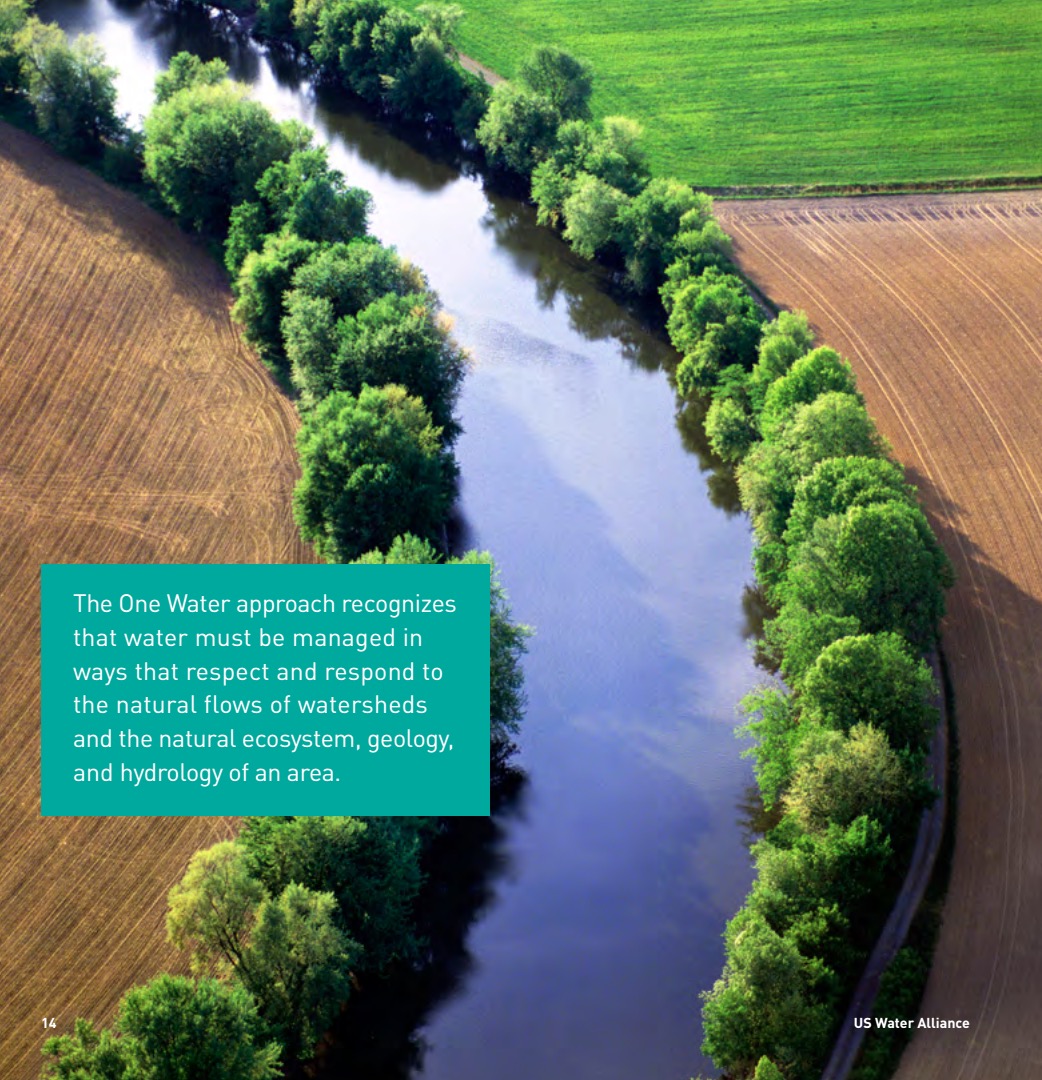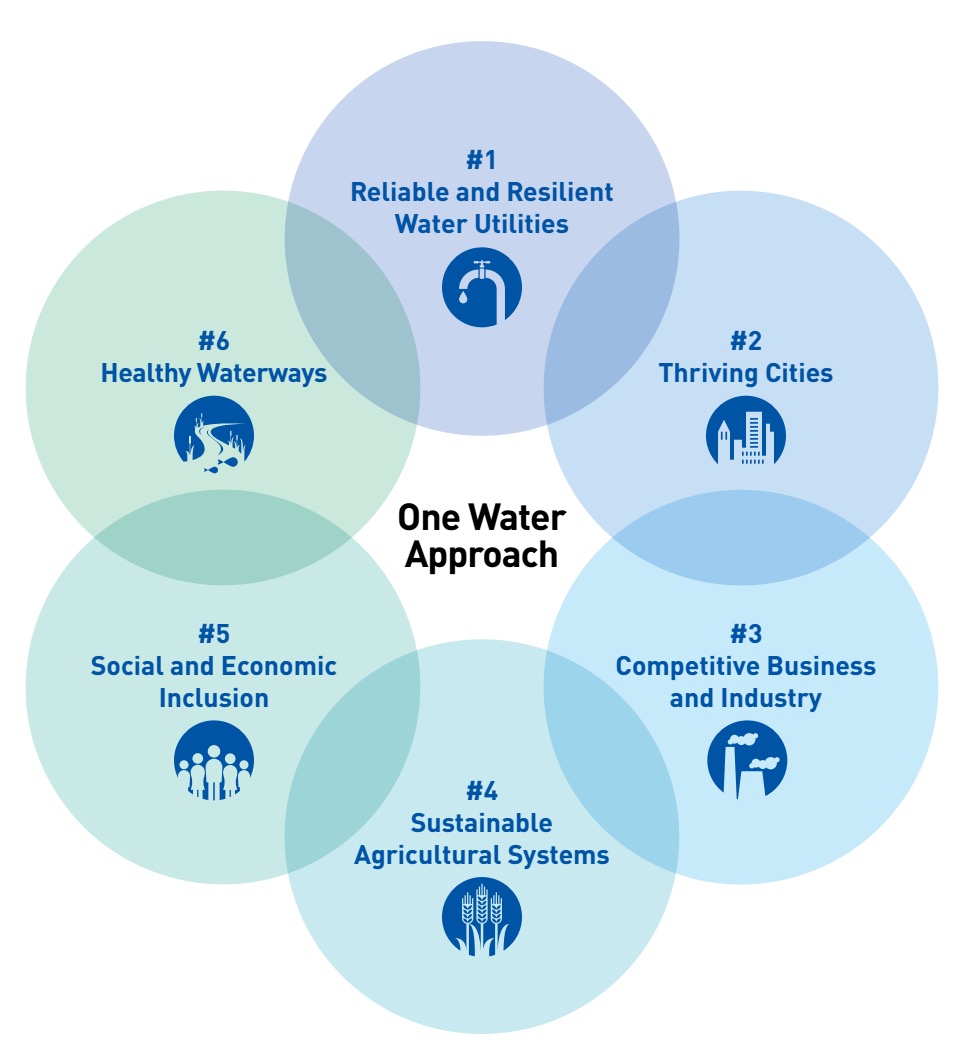U.S. WATER ALLIANCE
 Water is our world’s most precious resource and essential to everything we do.
Water is our world’s most precious resource and essential to everything we do.
It nourishes us. It cleans and sustains us. Put simply, we ARE water. On average, every American uses 176 gallons of water per day—that is over 64,000 gallons a year. Food production alone is responsible for 80 percent of all water consumed in the United States.
No matter who we are, where we live, or what we do, water connects all of us. When we embrace the belief that water in all its forms has value—water in our lakes, seas, rivers and streams, drinking water, wastewater, and stormwater—the full water life cycle can be optimized to build strong economies, vibrant communities, and healthy environments.
Our country should rightfully be proud of our investment in the systems and infrastructure that provide so many residents and businesses with reliable water and wastewater service, while protecting public health and the environment. However, many of the traditional assumptions and approaches used over the past 200 years to design, build, and operate our existing systems are insufficient to meet the 21st century challenges we face.
For example, regulatory, financial, and governance structures have put water into separately-managed silos for drinking water, wastewater, and stormwater. The stovepipes have been reinforced at every level of government—from the Clean Water Act and Safe Drinking Water Act at the federal level, to how water rights and regulation are managed at the state level, to the fragmented nature of how local utilities and city agencies are organized. In addition, water resources are influenced by agricultural, industry, and ecosystem management— often in ways that are separate from the decisions made by water utilities and community actors within the same watersheds.
Solving today’s water problems requires breaking down barriers not only within the water industry, but also among all the other stakeholders who influence, and are influenced by, the management of water resources. This includes community and business leaders, industries, farmers, environmental advocates, conservationists, policymakers, academics, and many others. They all play important roles in the quest to secure a sustainable water future for all.
The idea of an integrated systems approach to water is not new. Its full-scale implementation, however, has yet to be realized. There are many signs that water management in the US is entering another great era of change and innovation. All around the country we are seeing silo-busting examples of integrated and inclusive approaches to water resource management. These approaches exemplify the view that all water has value and should be managed in a sustainable, inclusive, integrated way. We call this perspective One Water. And while our focus is water, our goals are thriving local economies, community vitality, and healthy ecosystems.
This report offers a framework for bold leadership towards One Water management in the United States. The report is organized in the following manner:
- The Current Landscape provides an overview of the varied water-related challenges that face our nation;
- The One Water Approach describes the vision and core principles that guide the One Water approach; and
- Arenas for Action reviews six key arenas where progress is already being made and greater success can be realized.
The Current Landscape
Water is the defining issue of our time. According to the World Economic Forum annual survey, representing 750 of the world’s top business and political leaders, water crises were identified as one of the top global risks to industry and society over the next decade. While many regions across the country face water-related challenges, they are nuanced and different depending on local circumstances. Some of the varied challenges we face with respect to water are summarized below.
Water Quantity—Too Much, Too Little
While water scarcity and flooding seem at opposite ends of the spectrum, they are the result of the same dynamics occurring globally and can have equally devastating impacts. Communities are confronting increased frequency and intensity of floods due to rising sea levels, extreme weather, and inadequate infrastructure. While today’s discussions about water shortages tend to focus on drought in the Western states, episodic water shortages have hit many communities throughout the US in the past decades—even traditionally water-rich areas like New York City, Atlanta, and Philadelphia. In addition, many of our aquifers—the underground rock layers that serve as huge storehouses for the groundwater that supplies drinking water to half the US population—are being depleted much faster than rain and snow can refill them.
Water Quality
Although the health of our nation’s waters has improved significantly over the past 40 years, threats to water quality remain. The US Environmental Protection Agency and state governments have identified nearly 39,000 bodies of water nationwide that do not meet federal or state standards for water quality because of pollution. In the Mississippi River Basin, for example, nutrients from 31 states are turning thousands of square miles of the Gulf of Mexico into a “dead zone,” where nutrient-fed algae blooms consume so much oxygen that fish and other sea life cannot survive. It is the largest of 166 dead zones documented in the United States, and the second largest in the world. Urbanization has increased the area of impervious surfaces, leading to increased urban pollutants such as sediments, heavy metals, and others to be washed into waterways like the Chesapeake Bay and Puget Sound. In addition, contaminants such as pharmaceuticals and microbeads are entering our waters and potentially harming aquatic species and drinking water supplies for many communities.
Ecosystem Degradation
Watersheds—land areas containing a common set of streams and rivers that all drain into a single larger body of water—represent our fundamental natural water system. They collect our rainwater, preserve it, and transport it. Communities rely on healthy watersheds and ecosystems to provide enough clean water supplies, assimilate waste, and much more. More than just for our own consumptive needs, healthy watersheds are critical for the natural world, sustaining the health of wildlife populations, aquatic species, forests, and other thriving ecosystems. Over the ages, nature has shaped our watersheds and positioned them in balance with their surroundings, but industrial development has taken its toll. The global ecosystem has been valued as high as $145 trillion per year in 2007 dollars, and it is vanishing at a rate of $4 trillion to $20 trillion per year. In addition, as cities develop and generate more stormwater and wastewater and as storm activity grows more intense, existing infrastructure often no longer has the capacity to accommodate the increased volumes of water flowing into it. This leads to flooding, erosion, combined sewer overflows, and habitat destruction as runoff rushes untreated into local rivers and streams.
Aging and Inadequate Infrastructure
While nature provides water, it takes pipes, pumps, reservoirs, treatment plants, and people working 24/7 to deliver clean water to homes and businesses, and to remove and treat wastewater so it can safely be reused or returned to the environment. Much of that infrastructure was built more than 100 years ago, often for communities with drastically different population and economies than exist today. Some communities are growing, and water systems are straining to keep up in the face of a growing population and economic base. Meanwhile other communities, particularly in America’s Rust Belt, have systems built for larger populations and now face the challenges of systems with excess capacity and a declining fiscal base. Additionally, different climate conditions and weather patterns stress and strain systems. We average about 250,000 water main breaks per year in the US—that’s nearly one every two minutes. The American Society of Civil Engineers gave our drinking and wastewater systems a D grade. Neglected and outdated infrastructure causes a number of water quality problems, from lead in drinking water to contaminated lakes and oceans that suffer from raw sewage overflows. According to the US Environmental Protection Agency, our nation needs $300 billion in wastewater infrastructure investments and $335 billion in drinking water infrastructure investments over the next 20 years. Failing pipes also undermine streets, causing ancillary damage, safety hazards, and negative impacts on economic activity.
Pricing and Affordability
Water is arguably the world’s most undervalued resource, as traditional approaches to pricing have not reflected the true cost of service. This is a particularly acute problem as there has been a steady decline in federal funding for water infrastructure. As a result, about 98 percent of water projects are financed by local water utilities.A recent survey found that only one-third of water utilities are operating under rate structures that provide adequate revenue to fully cover their costs. As infrastructure continues to age, utilities need to raise rates to pay for upgrades. Keeping rates affordable for economically disadvantaged people is a growing problem in both urban and rural communities. A multi-faceted approach is needed—one where water is priced to meet the growing needs for investment in the system, while ensuring that lower-income households have reliable and affordable water service.
A Changing Climate
Changing climate patterns are putting additional stress on our water resources and water infrastructure. In 2016, the World Bank released a report that illustrated how the impacts of climate change will primarily be felt through the changing water cycle, with large and uneven consequences to our food, energy, urban, and environmental systems. Some communities are suffering from drought as water supplies shrink, temperatures rise, and weather patterns shift, while other communities are experiencing increased flooding and severe storms. Aquatic ecosystems will be stressed by lower flows, higher temperatures, and more concentrated pollutant levels. Both inland and coastal communities are at risk for increasing flooding and severe weather changes, and demographic shifts, such as population centers increasing in dry states that do not have sustainable water supplies. Across the country, communities of all sizes need tools and strategies to become resilient to the effects of climate change. Smart land use planning, flood protection, coastal protection, and strengthening our water infrastructure are all important.
Clearly, the water challenges facing America are great. However, all across the country, innovative leaders are turning these challenges into opportunities to advance more sustainable and inclusive approaches to managing water resources.
Download full version (PDF): One Water Roadmap
About the U.S. Water Alliance
http://uswateralliance.org/
“The US Water Alliance advances policies and programs that build a sustainable water future for all. At the US Water Alliance, we believe that all water has value. It must be managed in a sustainable and inclusive manner to build strong economies, vibrant communities, and healthy environments. We are driving a one water movement—an approach to water stewardship that is innovative, inclusive, and integrated. As a member-supported national nonprofit organization, the Alliance educates the nation about the true value of water and proactively advances policies and programs that manage water resources to advance a better quality of life for everyone.”
Tags: OneWater, U.S. Water Alliance, Water, Water Quality







 RSS Feed
RSS Feed